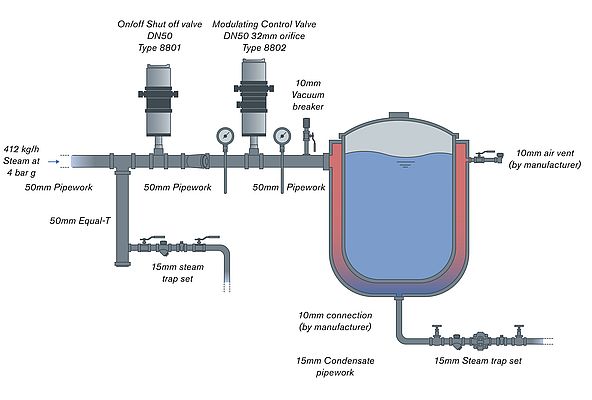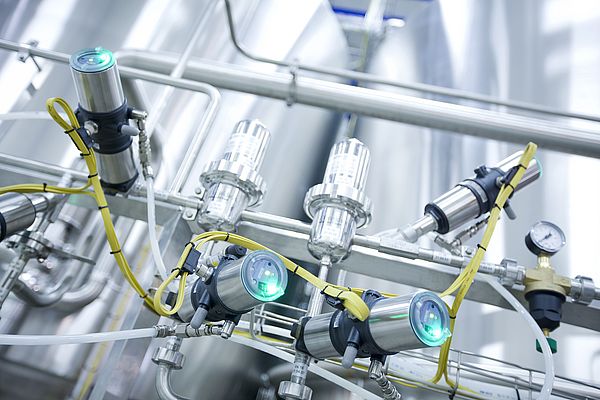Many industries use steam and compressed air as sources of heat and motive power and need to be managed properly in order to be used efficiently. Both are expensive to generate and so improving the level of consumption can have a significant impact on production costs. By assessing an existing process control structure and looking at alternatives, it is almost always possible to identify areas for improvement and start a program of worthwhile energy saving initiatives.
Steam management
Correctly designed steam processes can offer efficient use of this versatile product, however, get one calculation wrong or install a steam trap incorrectly and costs can start to escalate. Over sizing pipework can lead to unnecessary materials costs, increased installation costs from support structures and insulation. Larger pipework can also lead to increased condensate levels due to greater heat loss. This in turn will mean additional steam trapping is required or wet steam reaching the point of use resulting in reduced operational effectiveness. On the other hand, undersized pipework will result in a reduced pressure at the point of use, which may impede the performance of the equipment requiring the steam energy. The reduced size of the pipework will also increase the velocity of the steam which can cause water hammer and increased erosion levels.
Proper design not only saves energy, it also ensures safe and reliable operation. The Safety Valve for example is designed to protect the boiler shell from over-pressurisation and explosion and so sizing of the Safety Valve is a crucial process in order to ensure the proper safety levels are maintained. The valve must be able to pass the maximum possible flow rate in the event of a Pressure Relief Valve (PRV) failure, a point that can be overlooked in some cases. When it comes to ensuring the correct control valves are specified for a project, the number of variables is greatly increased and it may be advisable to seek expert assistance from a manufacturer, such as Bürkert. With access to a great deal of experience in designing steam applications, Bürkert experts are available to offer advice and sizing options to best suit your application needs.
When steam is used for temperature critical applications, such as cooking, the temperature is often set at a critical control point (CCP) which is designed to reduce the specific risk of Salmonella. Manufacturers require this as part of their food safety programme and it sets the minimum energy requirement for a process. Using a properly controlled system with data-logging facilities, will help to ensure that the programme is consistently implemented and the evidence recorded. However, heating costs need to be properly managed as well, so finding the right balance between heat produced mechanically and heat from steam is essential to maximise the efficiency of the process. Careful management of the steam through the use of intelligent valves that are directly linked to the temperature sensors, ensures that the steam energy is used in the most efficient manner. These process valves and their installation can also influence the energy efficiency of the compressed air system, which also comprises a significant cost of production.
Compressed air
Creating compressed air is a fundamental, if expensive, requirement for many process control applications and so employing the most efficient layout and valve design can provide significant savings. The generation cost of compressed air is equivalent to about 10 per cent of industry's total electricity usage, rising to 30 per cent in some sectors. This highlights why companies have compelling reasons to pursue energy saving initiatives in this area. However, one area of pneumatic energy saving potential is still largely unexploited: improved process valve control techniques.
The centralised control concept is the most traditional of installations but the major drawbacks of this design is the extended control air lines that increase air consumption and the negative effect on the switching times of the valves. Decentralised automation is a more recent concept. It employs intelligent pneumatic process and control valves for all production processes and utility circuits such as cleaning agents, steam or temperature control. The use of decentralised automation system, employing innovative intelligent process valves, eliminates the problems of centralised systems, because automation functions - pilot valves, electrical and optical position feedback and fieldbus interfaces - are integrated directly into the actuators of the process valves. Each process valve is connected directly to the main compressed air supply line in the field, reducing the number and length of tube and cable connections. This approach minimises the number of cables and compressed air lines, which significantly reduces the losses and subsequently the energy costs that are attributed to the compressed air circuit.
Bürkert Fluid Control Systems has developed a range of valve controllers specifically for use in the food, beverage and pharmaceutical industries. These valve units provide a distributed method of opening and closing of process valves automatically, thereby eliminating the need for the wasteful venting of control air, normally associated with pneumatic tubing between the process valve and its related control solenoid valve. The Bürkert valve controller is mounted directly above the valve body. This close coupling means that there is little or no distance between the actuator and the valve that it is piloting and this in turn means that there is no air bleed. The unit is completely sealed and so the energy from the compressed air is not wasted, again reducing the energy requirements of the process.
Conclusion
Energy costs are continually rising and for companies to remain competitive it is important that they adopt and integrate new technologies that can use their resources more efficiently. At the same time, manufacturers, such as Bürkert, continue to develop more efficient and more reliable products that require less energy and so help their customers to achieve their goals.

























































